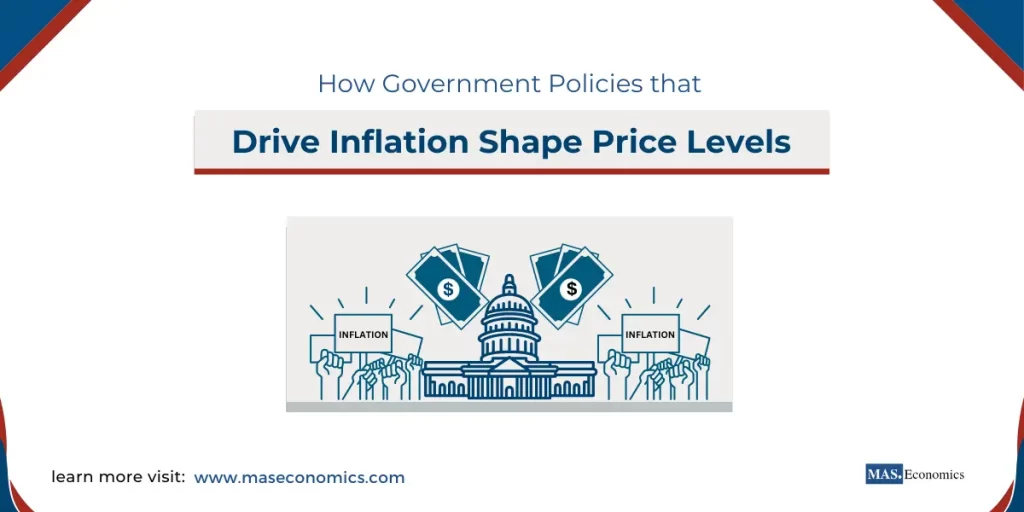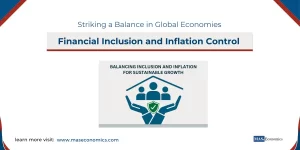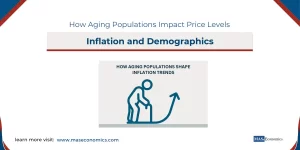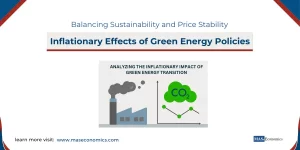Inflation is a complex economic phenomenon shaped by numerous factors, including market dynamics, consumer behavior, and monetary policies. A particularly influential yet often overlooked driver of inflation is government policies that drive inflation. Policies such as expansive fiscal stimulus, subsidies, and large-scale infrastructure investments can unintentionally contribute to inflationary pressures. Examining historical and recent examples, including pandemic-era stimulus packages, reveals the multifaceted relationship between government interventions and inflation.
Understanding How Government Policies Cause Inflation
Government actions can influence inflation in many ways, either through direct policy initiatives or through the ripple effects that such initiatives create. Inflation due to government policies that drive inflation generally emerges from three primary categories:
- Expansive Fiscal Stimulus Programs
- Subsidy Schemes
- Government Infrastructure Spending
In many cases, these policies are designed with the best of intentions—to stimulate growth, reduce unemployment, or provide relief in times of crisis. However, unintended consequences, such as increased consumer demand or disruption in supply chains, can lead to price level surges.
Expansive Fiscal Stimulus Programs and Inflation
The Pandemic-Era Example: A Case Study
The pandemic-era stimulus is one of the most prominent recent examples of how expansive fiscal stimulus programs can trigger inflation. In 2020, with COVID-19 spreading rapidly, governments across the globe injected trillions of dollars into their economies. The aim was simple—prevent a complete collapse of the global economic structure by boosting purchasing power.
Countries like the United States rolled out direct payments to households, payroll support, and business loans totaling more than $5 trillion. While these measures helped avoid severe recession, they also triggered unforeseen inflationary pressures.
Increased Consumer Demand
Consumers, flush with cash, began purchasing goods—particularly durable goods that had been otherwise inaccessible during lockdowns. This surge in demand, coupled with strained supply chains, caused a significant increase in prices, triggering what we now know as post-pandemic inflation.
Delayed Supply Response
Supply chains, disrupted by global lockdowns and production halts, struggled to keep up with the sudden increase in demand. With the supply curve unable to adjust, the price level began to rise.
The U.S. Federal Reserve noted that about 60% of the rise in prices could be attributed to demand-side factors, while the remaining 40% stemmed from supply-side constraints. This imbalance between supply and demand underscores how even well-intentioned government policies that drive inflation can trigger price increases if they outpace an economy’s productive capacity.
Historical Context: The Post-WWII Spending Boom
This scenario isn’t unique to the pandemic. A similar instance occurred following World War II when governments in the U.S. and Europe embarked on massive spending to rebuild their economies. This sudden influx of public spending, combined with pent-up consumer demand, led to a spike in inflation rates during the late 1940s and early 1950s.
Subsidies and Price Distortions
Agricultural Subsidies
Government subsidies, particularly in agriculture, are another form of state intervention that can distort price levels. For example, subsidies on fertilizers and seeds are intended to help farmers by reducing their production costs. However, such government policies that drive inflation often have unintended consequences:
Artificial Price Suppression and Overproduction
Subsidies may cause overproduction, and when too much supply floods the market, the overall costs of production can increase in the long run as inefficiencies become entrenched.
Impact on Consumers
On the consumer side, subsidies initially keep prices low. But, over time, as production processes grow inefficient or resource shortages emerge, these savings are often offset by higher costs elsewhere in the supply chain, ultimately leading to inflation.
The effect of agricultural subsidies in developing nations like India has been a prime example of how subsidy-driven demand and inefficiencies in supply chains contribute to inflation over time.
Government Infrastructure Spending
Infrastructure spending is often touted as a means of stimulating economic growth, creating jobs, and developing long-term assets. Yet, such massive investments can have unintended inflationary effects:
Housing Market Inflation
During and after the 2008 financial crisis, countries like the UK introduced stimulus policies such as housing subsidies and tax cuts on real estate transactions (e.g., the Stamp Duty Holiday in 2020). These measures were intended to spur economic activity and keep the housing market afloat during uncertain times.
However, the result was a sharp increase in demand, which, in an inelastic market like real estate, led to skyrocketing home prices. When supply cannot keep pace with demand—especially for non-manufacturable assets like land and homes—prices inevitably rise, pushing up inflation.
Transportation and Energy Sectors
Infrastructure spending in transport and energy, aimed at fostering long-term economic benefits, can also create short-term inflation. For instance, when governments invest in highways or electricity grids, it generally results in:
Increased Demand for Construction Materials
Cement, steel, and labor all see increased demand, which can lead to rising prices for these inputs, contributing to cost-push inflation.
Broader Impact on Industries
The increase in raw material costs can affect industries beyond infrastructure, indirectly raising the cost of various consumer goods.
Policy-Driven Inflation
Government policies that drive inflation create inflation mainly through demand-pull and cost-push mechanisms:
Demand-Pull Inflation
When policies are implemented to boost consumer spending or business investment, they increase aggregate demand. If an increase does not match the increase in demand in supply, prices are pulled upwards.
Example: Post-pandemic stimulus payments led to higher consumption of goods, especially as people spent more on home improvements and consumer electronics. Supply, still disrupted by the pandemic, lagged behind, and prices rose.
Cost-Push Inflation
On the other side, policies such as increased taxes, higher minimum wages, or subsidies on certain commodities can lead to cost-push inflation. These policies raise production costs, which are eventually passed on to consumers.
Example: During the 1970s, governments worldwide imposed wage and price controls to contain inflation. Ironically, these controls ended up causing even more severe shortages, leading to a second round of inflationary pressures.
The Role of Central Banks in Mitigating Policy-Driven Inflation
While governments play a crucial role in fostering economic stability, central banks are often tasked with mitigating inflation once it emerges. One way central banks intervene is by adjusting interest rates.
Interest Rate Hikes to Combat Inflation
Central banks, such as the U.S. Federal Reserve or the European Central Bank, may increase interest rates to make borrowing more expensive. This move can effectively cool down consumer spending and investment, bringing down inflation. However, this approach risks curbing economic growth and leading to higher unemployment.
Quantitative Tightening
Another tool central banks use is quantitative tightening, where they sell off government securities or allow them to mature. By reducing the amount of money circulating in the economy, inflation can be reined in—though this, too, comes with potential trade-offs, such as reduced market liquidity.
Historical Lessons: When Policies Backfire
To better understand the impact of government-driven inflation, let’s consider two key historical examples:
The Great Bengal Famine of 1943
During World War II, the British government prioritized war-related spending over civilian needs in India, leading to significant inflation in food prices. Despite there being no severe shortage of food, inflation rendered it unaffordable to large parts of the population, ultimately leading to famine conditions. This highlights how government priorities in times of crisis can lead to uneven outcomes, disproportionately affecting vulnerable segments.
The Hyperinflation in Zimbabwe (2000s)
Inflation spiraled out of control largely because of government policies. In Zimbabwe, land reforms and excessive printing of money to cover fiscal deficits led to one of the most extreme episodes of hyperinflation in modern history. This episode serves as a stark warning of how unrestrained government spending, coupled with fiscal mismanagement, can completely erode an economy.
Modern Examples: The Pandemic’s Lingering Impact
The COVID-19 pandemic provides another clear example of policy-induced inflation, as previously discussed. Beyond expansive fiscal policies, subsidies for specific sectors also led to distortions:
Energy Subsidies
Governments provided energy subsidies to households to help them cope during the pandemic. However, as energy markets stabilized, maintaining these subsidies led to artificial demand growth, thereby contributing to inflation when the supply of natural gas and oil was affected by global disruptions.
Labor Market Distortions
Generous unemployment benefits, while vital during the lockdown, created labor shortages in some sectors, pushing up wages and costs for businesses. As a result, these increased costs were passed on to consumers, thereby driving inflation further.
Conclusion
Government policies that drive inflation are a critical lever for maintaining economic stability, fostering growth, and addressing crises. However, as history has repeatedly shown, even the most well-intentioned interventions can trigger unintended inflationary effects if not carefully managed. Fiscal stimulus, subsidies, and infrastructure investments, while valuable in certain contexts, can create imbalances when they exceed the economy’s capacity to absorb them.
To mitigate inflationary pressures, policymakers must strike a balance—supporting growth while ensuring that demand does not outstrip supply. Coordination between fiscal and monetary authorities becomes particularly important, as central banks need to align their strategies with government policies to avoid overheating the economy.
FAQs:
How can government policies drive inflation?
Government policies, such as fiscal stimulus, subsidies, and infrastructure spending, can drive inflation by increasing demand or production costs. When demand outpaces supply, prices rise (demand-pull inflation), and when production costs increase due to policies, businesses pass these costs to consumers (cost-push inflation).
How did pandemic-era stimulus programs contribute to inflation?
Pandemic stimulus programs aimed to support economies during lockdowns but also drove inflation by increasing consumer spending power. With stimulus checks, consumers began purchasing more goods, especially durables, causing a surge in demand. However, global supply chains were disrupted, unable to meet this demand, leading to rising prices.
What role do subsidies play in inflation?
Subsidies, while intended to reduce prices and support industries, can lead to inflation over time. Agricultural subsidies, for instance, may encourage overproduction and inefficiencies, pushing production costs up. In some cases, subsidies create artificial demand, which can lead to long-term price increases across the supply chain.
How does government infrastructure spending affect inflation?
Government infrastructure spending can lead to inflation by increasing demand for construction materials like steel and cement and raising prices in related sectors. For instance, large-scale projects drive up the costs of raw materials and labor, indirectly increasing prices for other consumer goods.
How do housing policies impact inflation?
Housing policies, such as subsidies or tax cuts, can spur demand in real estate. If the housing supply cannot keep pace with this demand, prices rise, pushing up inflation. For example, policies like the UK’s Stamp Duty Holiday during COVID-19 boosted home buying but also contributed to a housing price surge.
How can central banks mitigate inflation caused by government policies?
Central banks can counter policy-driven inflation by raising interest rates, making borrowing more expensive to slow consumer spending and business investment. They may also use quantitative tightening, reducing the money supply to cool inflation. However, these methods risk slowing economic growth.
How did post-WWII spending lead to inflation?
Post-WWII spending in the U.S. and Europe aimed to rebuild economies but also increased inflation by spiking demand amid supply shortages. Governments directed funds toward public works and military expenditures, but with limited supply, this led to higher prices as demand surged.
What were the inflationary consequences of pandemic-related energy subsidies?
Pandemic-era energy subsidies initially helped households cope with rising energy costs. However, as energy markets stabilized, sustained subsidies increased demand, contributing to inflation. When global supply disruptions emerged, the artificial demand from subsidies led to even higher energy prices.
Thanks for reading! Share this with friends and spread the knowledge if you found it helpful.
Happy learning with MASEconomics




